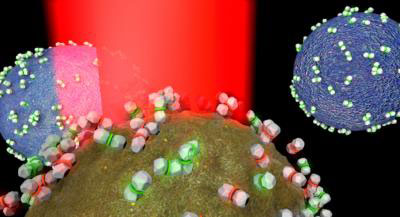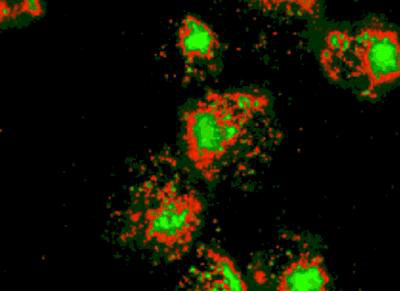|
|
|
|
 News Feeds News Feeds
|
 Join us on Facebook Join us on Facebook
|
 Follow us on Twitter Follow us on Twitter
|
|
? Posted: Sep 20th, 2011 Posted: Sep 20th, 2011 Posted: Sep 20th, 2011 Posted: Sep 20th, 2011 Posted: Sep 20th, 2011 Posted: Sep 20th, 2011 Posted: Sep 20th, 2011 Posted: Sep 20th, 2011 Posted: Sep 20th, 2011 Posted: Sep 20th, 2011 Posted: Sep 19th, 2011 Posted: Sep 19th, 2011 Posted: Sep 19th, 2011 Posted: Sep 19th, 2011 Posted: Sep 19th, 2011 Posted: Sep 19th, 2011 Posted: Sep 19th, 2011 Posted: Sep 19th, 2011 Posted: Sep 19th, 2011 Posted: Sep 19th, 2011 Posted: Sep 18th, 2011 Posted: Sep 18th, 2011 Posted: Sep 18th, 2011 Posted: Sep 17th, 2011 Posted: Sep 16th, 2011 Posted: Sep 16th, 2011 |
| Posted: Sep 19th, 2011 | |
| Breakthrough technology uses nanopacticles to identify prostate cancer cells | |
| (Nanowerk News) A team of researchers at UC Santa Barbara has developed a breakthrough technology that can be used to discriminate cancerous prostate cells in bodily fluids from those that are healthy. The findings are published this week in the Proceedings of the National Academy of Sciences ("Quantitative ratiometric discrimination between noncancerous and cancerous prostate cells based on neuropilin-1 overexpression"). | |
| While the new technology is years away from use in a clinical setting, the researchers are nonetheless confident that it will be useful in developing a microdevice that will help in understanding when prostate cancer will metastasize, or spread to other parts of the body. | |
 |
|
| Cancerous and non-cancerous cells are incubated with silver nanoparticle biotags, and then analyzed by shining the red laser on them. The biotags are shown on the cells' surface. Those glowing red in the middle are the cancer biomarkers, and those glowing green are standard biomarkers that bind to many cell types. A high ratio of red to green is found on the cancer cells. | |
| "There have been studies to find the relationship between the number of cancer cells in the blood, and the outcome of the disease," said first author Alessia Pallaoro, postdoctoral fellow in UCSB's Department of Chemistry and Biochemistry. "The higher the number of cancer cells there are in the patient's blood, the worse the prognosis. | |
| "The cancer cells that are found in the blood are thought to be the initiators of metastasis," Pallaoro added. "It would be really important to be able to find them and recognize them within blood or other bodily fluids. This could be helpful for diagnosis and follow-ups during treatment." | |
| The researchers explained that although the primary tumor does not kill prostate cancer patients, metastasis does. "The delay is not well understood," said Gary Braun, second author and postdoctoral fellow in the Department of Molecular, Cellular, and Developmental Biology. "There is a big focus on understanding what causes the tumor to shed cells into the blood. If you could catch them all, then you could stop metastasis. The first thing is to monitor their appearance." | |
| The team developed a novel technique to discriminate between cancerous and non-cancerous cells using a type of laser spectroscopy called surface enhanced Raman spectroscopy (SERS) and silver nanoparticles, which are biotags. | |
 |
|
| Cells shown in the image are cancerous. The simple color code makes visual identification easy. Red indicates the cancer biomarkers. | |
| "Silver nanoparticles emit a rich set of colors when they absorb the laser light," said Braun. "This is different than fluorescence. This new technology could be more powerful than fluorescence." | |
| The breakthrough is in being able to include more markers in order to identify and study unique tumor cells that are different from the main tumor cells, explained Pallaoro. "These different cells must be strong enough to start a new tumor, or they must develop changes that allow them to colonize in other areas of the body," she said. "Some changes must be on the surface, which is what we are trying to detect." | |
| The team is working to translate the technology into a diagnostic microdevice for studying cancer cells in the blood. Cells would be mixed with nanoparticles and passed through a laser, then discriminated by the ratio of two signals. | |
| The two types of biotags used in this research have a particular affinity that is dictated by the peptide they carry on their surface. One type attaches to a cell receptor called neuropilin-1, a recently described biomarker found on the surface membrane of certain cancer cells. The other biotag binds many cell types (both cancerous and non-cancerous) and serves as a standard measure as the cells are analyzed. | |
| In this study, the team mixed the two biotags and added them to the healthy and tumor cell cultures. The average SERS signal over a given cell image yielded a ratio of the two signals consistent with the cells' known identity. | |
| Pallaoro said she believes the most important part of the new technique is the fact that it could be expanded by adding more colors ?? different particles of different colors ?? as more biomarkers are found. The team used a new biomarker discovered by scientists at UCSB and the Sanford Burnham Medical Research Institute. |
?
?
Source: http://www.nanowerk.com/news/newsid=22788.php
chelsea handler craiglist netflix apple stock danica patrick berkshire hathaway j cole
No comments:
Post a Comment